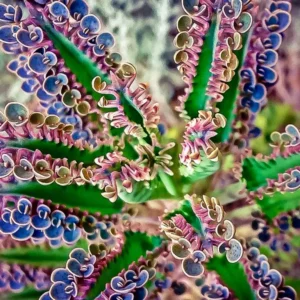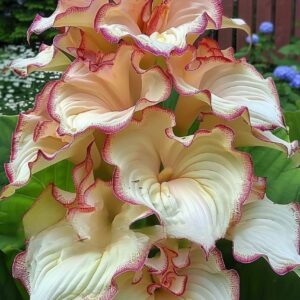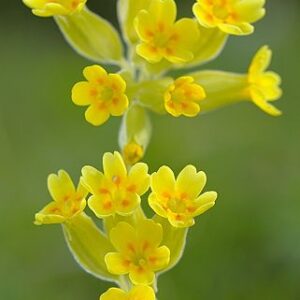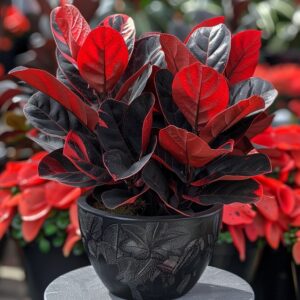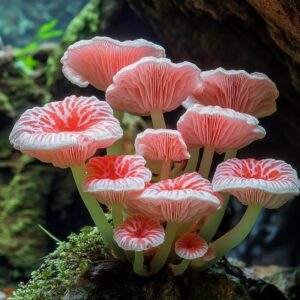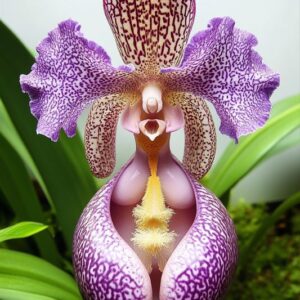


That’s how I ended up singing the praises of Oxalis triangularis (aka the purple shamrock or false shamrock houseplant) to some of my friends.
You know where you stand with a purple shamrock. If it droops, it’s thirsty. If it stays closed during the day, it needs more light. And if it moves away from the light, then it’s getting too much light. Easy, right?
However, there was one detail about this plant that I forgot to mention. And it had my friend panicking a few months into growing this plant. I’ll tell you about it a bit later. For now, let me give you a few reasons why you should make the purple shamrock your next houseplant purchase.
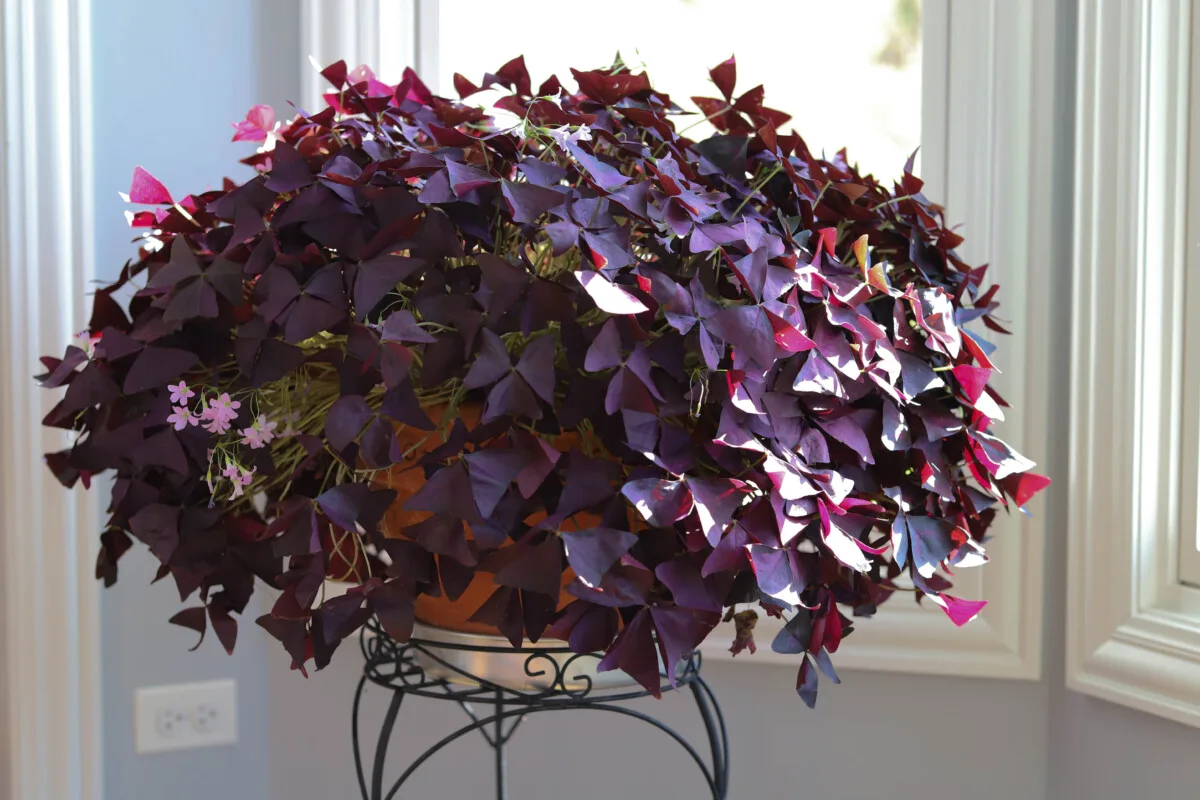
It’s the color that makes the purple shamrock one of my favorite houseplants. I love the deep shade of burgundy complemented by the fuchsia spots and the lavender flowers.
I live in the Northern Hemisphere, in a climate that’s far from tropical. So when it comes to keeping houseplants, I often feel that I’m missing out on growing colorful houseplants that bloom abundantly. I turned blooming begonias and coleus from garden plants to indoor plants; but I enjoy having colorful plants all year long, without having to wait for the blooms.

With its deep purple triangular-shaped foliage – reminiscent of a butterfly’s wings – the Oxalis triangularis stands out from the crowd, adding variety to the usual green hues of my plant corners.
I think oxalis is as forgiving a houseplant as they come. Its easygoing nature is due to the fact that it grows from corms (the root structure that looks like a tiny bulb). It helps the plant store enough energy that makes it more resilient through periods of neglect.

Purple shamrock does really well in bright, indirect light, so placing it in front of an east-facing or west-facing window is best. If you place it too close to a south-facing window, the leaves might get burned at the height of summer. The scorch will show up as brown patches starting at the edges of the leaf. Just move it a few feet back or place it behind a sheer curtain.
What about watering my Oxalis triangularis?
Yes, water it when the top couple of inches feel dry to the touch. Soak the soil through and let the water drain out of the bottom of the pot. Overwatering is our biggest enemy, in this case, because we don’t want to keep the corms in too much moist soil.

I usually allow my oxalis to get dry between watering sessions. Not rock hard, but the top inch of soil is definitely dry enough before I water it. When the plant is actively growing (generally in spring and fall, depending on temperatures), I try to keep the soil somewhat moist.
When my oxalis enters dormancy (we’ll talk about it more below), I taper down the watering (but not completely reduce it) until I see new signs of growth.
At first sight, it may seem like the purple leaves are the flowers. Nope, they’re not. The flowers themselves are dainty little blooms in shades of pale pink, white or lavender.
My oxalis plants start blooming in late spring and keep going strong through early summer. During hot summers, they tend to take a bit of a break, but they’ll start reblooming again in the fall.

I’ve had years when the purple shamrock has bloomed continuously for months, including throughout the summer months. (I think the record was six months, when it was really happy in one particular spot.)
The flowers are edible in very small quantities – for example, as a garnish on a salad or a piece of cake. They taste a bit like a lemon or a green apple – slightly tart and citrusy. In fact, one of my oxalis plants even came with the “edible” label.

However, be aware that the oxalic acid contained in the flowers and the leaves may be toxic to humans and pets if consumed in large quantities. Personally, I’ve tried it, but I’m not a big fan of its tart taste. I’d rather keep the flowers on the plant. They bring me more enjoyment from looking at them than from consuming them.
Oxalis triangularis plants grow from corms. These are tiny bulb-like structures that, just like bulbs, can self-propagate. So if you start with ten bulbs in a pot, you might end up with twenty in a year’s time. That all depends on whether your plant has the right conditions, of course. Here’s what I found when I was repotting one of my plants. This whole structure started from one corm.

The nice thing is that you can get away with only buying a potted oxalis once, then you can keep dividing the corms every year. For the corms to keep self-propagating, they need plenty of room in the container.
So I realized that I either needed to upsize the container every year or take some of the bulbs out and start a new plant. I usually do this division before the plant starts growing again after the cold months.

Because I don’t always want to start new plants, I end up taking some of the corms out and dotting them around other plants, usually in outdoor containers.
You can buy purple shamrock corms online here to start your own plants. This is a really affordable way to start many plants.
Ok, I admit that not everybody is as fascinated by this as I am. But I like a plant that tells me when it’s time to go to sleep.
This phenomenon is called nyctinasty and it refers to the response of the plant to the circadian rhythms. You’ll notice that as it gets darker the leaves start folding around the central vein, making the plant appear wilted.

Then as soon as the light levels increase in the morning, the leaves and flowers start perking up again in response to the light. The downside is that the plant may look a bit droopy on super cloudy days. But so do I, so I’m not judging.
And due to this folding and unfolding in response to the light, another nickname oxalis goes by is butterfly shamrock. Isn’t that cute?

But here’s the catch: Purple shamrock will behave the same – closing up like an umbrella – when it’s really thirsty. So if your plant stays closed during the day, check whether the soil is dry. If it is, just give it a good soak and watch it open up in relief.
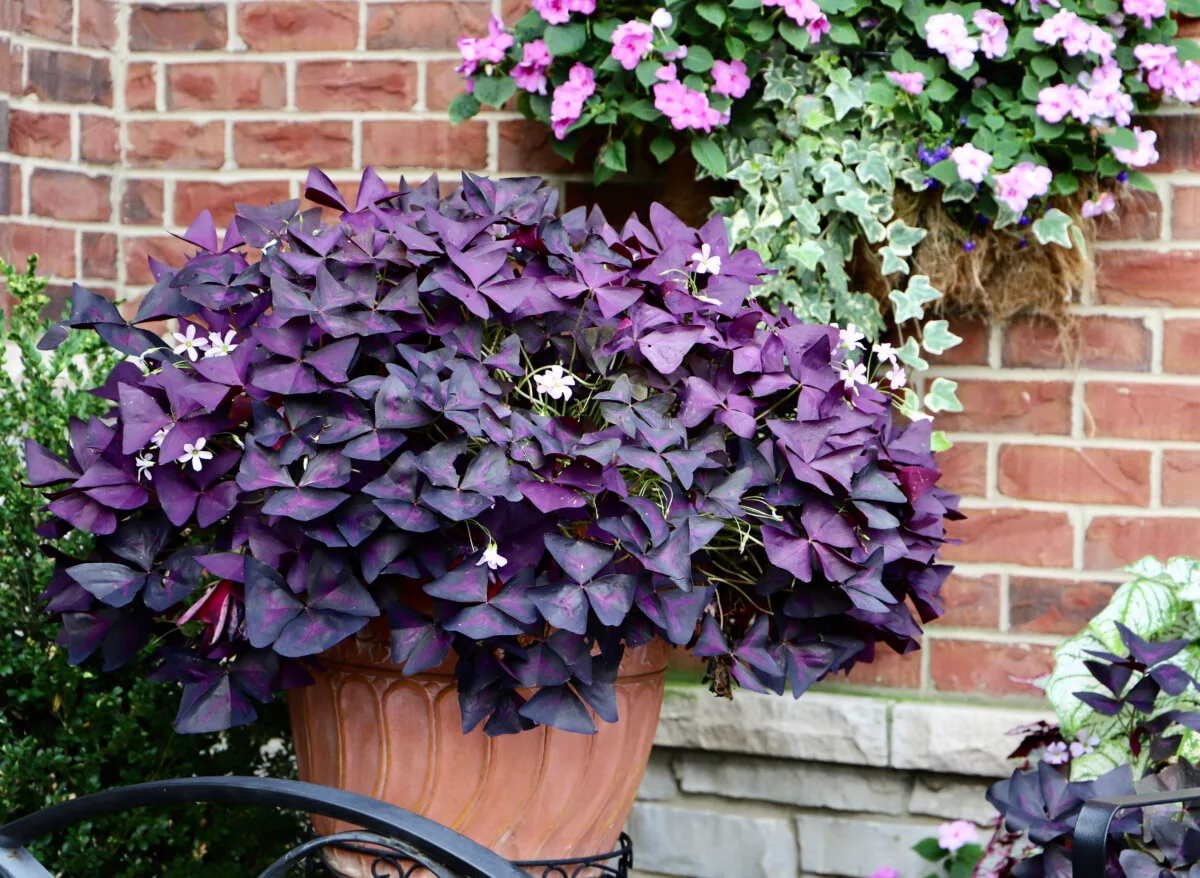
I’ve already mentioned this story in my article on garden plants that I turned into indoor plants. About five years into growing purple shamrock as a houseplant, I decided to move it outdoors to see what would happen. What happened was that it absolutely thrived. Even though it was doing well indoors, it absolutely exploded into a sea of burgundy when I moved the container to my deck.
One thing to keep in mind is that oxalis is a tender plant. So it will not stay in bloom – or even in foliage – over the cold months.

Once the temperatures start dipping into the low 50s F (that’s about 10-14 Celsius), you have to make a decision:
- Bring the oxalis indoors, where it will continue to grow as a houseplant; OR
- Leave it outside, where everything above ground will completely die off until spring.
At different times in the past, I’ve done both. I should mention that, even when I brought my purple shamrock inside for the winter, it still entered a period of dormancy. The plant has to complete its life cycle.
However, indoors it wasn’t as dramatic as losing everything above soil level. It still had some leaves, though fewer than during the summer; as expected, it didn’t flower in winter. It limped along for a couple of months (roughly from November until February), then it started sprouting new leaves again.
Will purple shamrock survive outdoors over the winter?
If you decide to keep it as a garden plant exclusively, you still need to protect the corms if the temperatures dip below freezing.

I moved the entire pot – soil and buried corms – to my shed and covered it in bubble wrap. Keeping it in a cool, frost-free place ensures that the plant remains dormant.
The trick is to remember to take it out in spring. That’s when you need to start watering it again and exposing the young shoots to enough light to jumpstart their growth. Remember that these are not hardy bulbs (such as hyacinths, daffodils and tulips). So they won’t need to go through a cold spell (vernalization) in order to sprout again the following year. It’s best to keep them protected.
Will my purple shamrock enter dormancy?
This is the detail that I forgot to mention that baffled my friends. When they first bought their purple shamrock, they didn’t realize that this houseplant might go into dormancy. I say might, because, at least for my plants, it doesn’t happen every year.
There are generally two times a purple shamrock plant might go dormant.

Summer dormancy: This is triggered by high temperatures, generally anything above 80F (around 26C+). This happens after a plant has already bloomed in the spring, mainly because it’s conserving energy to bloom again in the fall. I found this usually happens with oxalis that spend some time outdoors, but it’s less likely with indoor plants.
Winter dormancy: This is triggered in the cold months, but the reason for purple shamrock mostly has to do with lack of light rather than cold temperatures. The plant starts losing leaves fast and at the same time stops growing new leaves. Over a month or so, with no leaf replacement, the pot itself looks pretty dead.

Some years, for my indoor oxalis plants this could look like a partial dormancy, with only a few strands hanging around until spring.
Even in spite of this quirk, I would recommend getting a purple shamrock houseplant to brighten up your decor.
You can purchase a live purple shamrock plant in a 4″ pot here, but it may be cheaper to purchase this pack of corms and growing your own.
